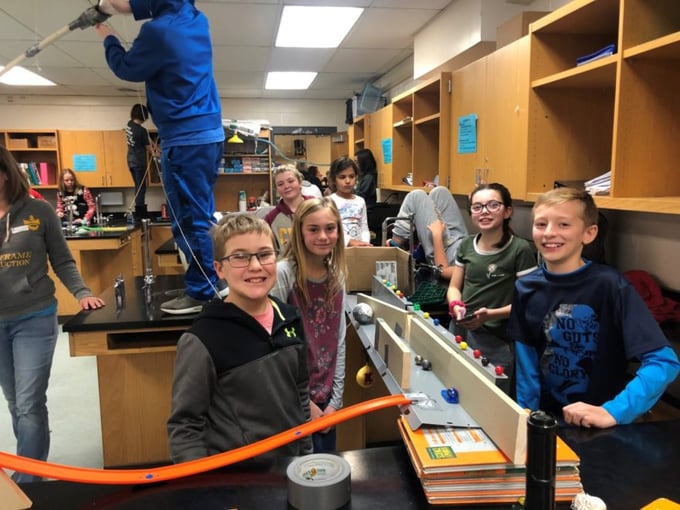Controlled chaos is a familiar term for PLTW students and teachers, but it takes on a whole new meaning for Rolland Warner Middle School students at the Center for Innovation in Lapeer, Michigan.
There, more than 200 students in sixth and seventh grade participate in the school’s annual – and massive – Rube Goldberg project, which they showcase to the community on Launch Day during the last week of classes before the holiday break.
“It is festive and messy and loud and crowded and oh so wonderful,” says Jaime Ratliff, STEM program coordinator at Lapeer Community Schools. “You can feel the energy and excitement crackling in the air. Students are full of anticipation. Parents and teachers are full of pride. The community is in awe of what the students have accomplished. Lots of positive vibes happening that day.”
Three PLTW Gateway teachers – Patrick Lothrop, Lani Ward and Rose Dodson – organize the project, along with the support of PLTW parents. All sixth and seventh grade PLTW Gateway students from the school’s Automation and Robotics, Design and Modeling, Medical Detectives, and Flight and Space classes participate in the project.
This year, the fourth annual Launch Day took place on Wednesday, Dec. 19. In attendance were the middle school’s PLTW Gateway students, their parents, members of the school board, the superintendent, building leadership, and local industry professionals.
“This event brings together our students, their families, our district leadership, and the community. It provides our students with real-world experience about how to respond the moment after a plan fails and allows students to practice not giving up. Those are authentic and unique opportunities,” Lothrop says.
How It Works
Assignment: Teachers assign each student group a portion of a Rube Goldberg machine that articulates with the groups before and after them.
Project Requirements: Students must build it themselves. Parents and teachers can offer limited help, but students are responsible for the construction of their portion of the Rube Goldberg.
They must bring in materials from home or use classroom items; purchasing is not required. Students complete their pre-planning and sketching, then they have five days (two hours each day) to build. Their portion of the Rube Goldberg machine must show understanding of potential energy, kinetic energy, and energy transfer.
Grading Criteria: Sketches and written plans are graded during pre-build time. Collaboration and effective communication skills are graded during the building phase. Students are not graded on whether their portion worked, but how they approached the problem and tried to solve it.
After Launch Day, students complete a reflective summary, detailing 1) how they used the engineering design process, 2) how design improvement evolved over the course of the five days, and 3) how important communication was during this time.
“We want students to use the skills they have been building with the PLTW program in a productive way. This provides an authentic situation for them to practice planning, communicating, refining design, setting short- and long-term goals, and working under criteria, constraints, and deadlines,” Ratliff says. “It is as close to a real-life employee workplace experience that we can provide. We do this in a supportive and fun way to help nurture them, but expectations are high and that helps them grow academically and pushes soft skill development as well. They can use these skills on whatever path they choose in their future.”
Hosting Your Own Rube Goldberg Project
The Center for Innovation’s Rube Goldberg project has grown since its inception, with more students participating and more community members attending Launch Day each year.
The result is a supportive environment that both helps students grow and learn from their mistakes, and showcases to the community what the school’s talented young students can do.
“The positive press and visibility of the event helps the community understand what opportunities we are offering students,” Lothrop says. “Because of this event, we have been able to secure some grants from local organizations.”
For other schools interested in replicating this project, Ward provides the following tips:
- Pre-plan to identify a timeframe and a dedicated but temporary space.
- Follow the steps of the engineering design process.
- Brainstorm ideas with students.
- Make thinking visible with sketches.
- Form groups, assign space, and gather materials.
- Allow work time.
- Ask leading questions and offer suggestions.
- Build!
- Invite community members and the press to show off students’ awesome work!
- Clean up.
Additionally, over the four years the PLTW Gateway teachers have organized this project, they’ve learned some valuable lessons along the way. Lothrop shares the following advice for other teachers looking to organize a Rube Goldberg project:
- Be patient with yourself and your students.
- Resist all urges to fix it for them!
- Keep checking in with students on their own work as well as how they are connecting with groups before and after.
- Complete lots of trial runs before the big Launch Day so they can see what needs to be fixed.
- Be positive and point out learning experiences (both good and bad).
- Don’t let a student quit.
- Be prepared to dry tears and resolve fights. The constraints are tough to deal with; keep the focus on what they can do to get past whatever hurdle they are struggling with.
- Listen and watch.
- Be amazed!
“[This project] provides a holistic approach to the PLTW philosophy. It lets students use an iterative process to design a portion of the Rube Goldberg machine using scientific understanding of energy and energy transfer. It introduces a situation that mimics real-world criteria and constraints – time being one of them. It provides ample opportunity for students to communicate in their own group and with others. They get to experience success and failure and learn how to handle the unique situations surrounding each. They get to learn from mistakes and complete a finished product that they can be proud of and showcase it in a supportive environment,” Ratliff says.


